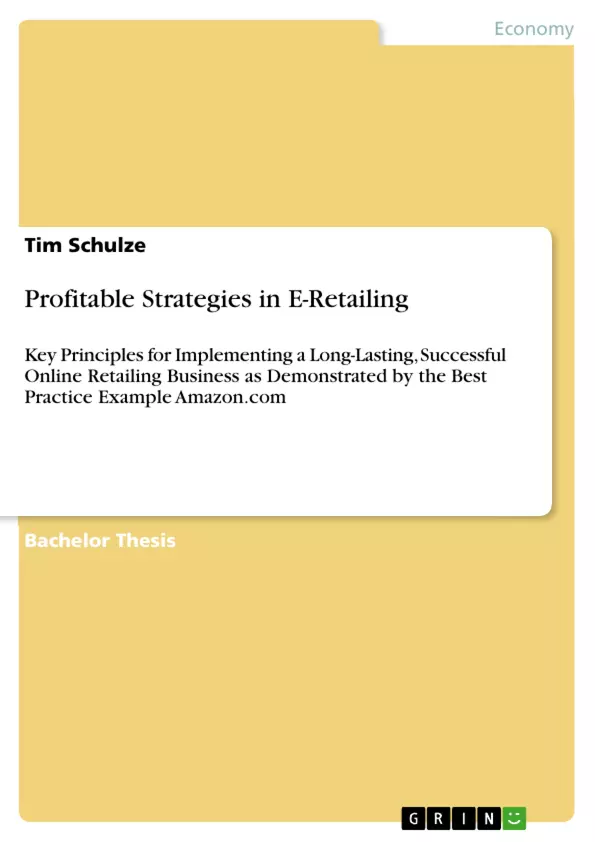The CEO of the largest American book retailer Barnes & Noble, William Lynch, announced in July 2013 that he will exit the company. This news came in the wake of the publication of alarming quarterly figures in June and the subsequent public realization that the company had accumulated significant losses in its electronic business division. Other companies such as Borders and Boo.com have also tumbled over and ultimately succumbed to the challenges of electronic retailing, or e-retailing, which were the result of changing customer needs and behavior, technological developments and a changed business environment. At the same time one company overtook these companies and quickly became the dominant, global force in e-retailing. Amazon.com has proven and continues to prove that innovative business practices can ensure profits even in a cut-throat environment such as online commerce. This dissertation examines the company’s most successful strategies for e-retailing and derives recommendations for creating profitable, long-lasting and all-around successful e-retailing businesses.
Table of Contents
- Introduction
- Barnes & Noble CEO Resigns Over Losses in the Digital Business
- Scope and Objectives of the Thesis
- Structure and Methodology
- Relevance of the Internet and its Significance for Retailers and Consumers
- Definitions of Terms and Concepts
- The different Aspects of E-Commerce and the Internet
- Development of the Internet Technology and its Effect on Consumer Behavior
- Essential Components of Retailing
- The Rise of the Internet in Correlation to Technological Progress and its Impact on Social Structures
- Effects of the Internet on Market Structures
- Consumers' Online Shopping Behavior and Phenomena
- Challenges of Consumer Online Shopping Behavior for Retail Businesses
- Business Models for E-Retailing and Essential Strategies for Success
- Theoretical Structure of a Business Model
- General Aspects and Retail-Specific Components
- Business Models in the E-Commerce Environment
- Benefits and Limitations of Different E-Retail Business Models
- Substantial Parts of an E-Retailing Strategy for Achieving a Competitive Advantage
- Sources of Competitive Advantage
- The Business Model and Strategy Formulation
- Types of Strategies and Evaluation
- Challenges of Strategy Implementation as Evident in the Economic Reality
- Analysis of Failed Online Retail Businesses
- Identified Threats and Core Issues Regarding the Execution of the Business Plans
- Amazon's Business Strategy and Tactics for Succeeding in the E-Retailing Environment
- Market Environment
- Technological Conditions and Customer Behavior
- Market Structure and Competitors
- Structure and Features of the Amazon Business Model
- Customer Satisfaction as the Core Notion of Amazon's Philosophy
- Leadership and Long-Term Vision
- Technology
- Logistics
- Marketing-Related Aspects
- Financial Strategies
- Methods for Adapting to Changing Circumstances
- Performance Measurement
- Criticism and Critical Evaluation of the Strategies
- Key Principles for Successfully Implementing an E-Retailing Business Plan
- Business Plan
- Success Factors
- Implementation
- Strategy Adjustment in the Process
Objectives and Key Themes
This thesis examines the key principles for implementing a successful and long-lasting e-retailing business, using Amazon.com as a best practice example. The research analyzes the factors contributing to Amazon's success, focusing on its strategy, business model, and ability to adapt to a rapidly changing digital environment.- The impact of technological advancements on the retail industry and consumer behavior.
- The evolution of e-commerce and the significance of strategic planning for online retailers.
- Key components of successful e-retailing strategies, including competitive advantage, market analysis, and customer satisfaction.
- The challenges of implementing e-retailing strategies in the face of changing market dynamics.
- The Amazon business model as a case study for successful e-retailing, highlighting its core principles and adaptations.
Chapter Summaries
The introduction highlights the changing landscape of retail with the example of Barnes & Noble's struggles in the digital market. It establishes the scope and objectives of the thesis, aiming to investigate successful e-retailing strategies through Amazon's example. Chapter 2 explores the relevance of the internet for both retailers and consumers. It analyzes the evolution of internet technology and its influence on consumer behavior, highlighting key aspects of online shopping and the challenges it presents for businesses. Chapter 3 delves into business models for e-retailing, exploring their theoretical structure, specific components, and benefits. It examines the essential elements of an e-retailing strategy for achieving a competitive advantage, outlining different types of strategies and evaluating their effectiveness. Chapter 4 focuses on Amazon's business strategy and tactics for succeeding in the e-retailing environment. It analyzes Amazon's market environment, including technological conditions and customer behavior, and explores the company's unique business model. The chapter examines various aspects of the Amazon model, such as customer satisfaction, leadership, technology, logistics, marketing, and financial strategies. Chapter 5 delves into key principles for successfully implementing an e-retailing business plan. It discusses the importance of a well-defined business plan, outlining success factors and implementation strategies. The chapter also emphasizes the necessity of adjusting strategies to accommodate evolving market dynamics.Keywords
The central focus of this thesis revolves around the core concepts of e-retailing, business strategy, and competitive advantage, with Amazon serving as a prominent case study. Key terms include e-commerce, digital retail, business model, customer satisfaction, technological advancements, competitive advantage, strategy implementation, market dynamics, and the Amazon business model.- Quote paper
- Tim Schulze (Author), 2013, Profitable Strategies in E-Retailing, Munich, GRIN Verlag, https://www.grin.com/document/263783



